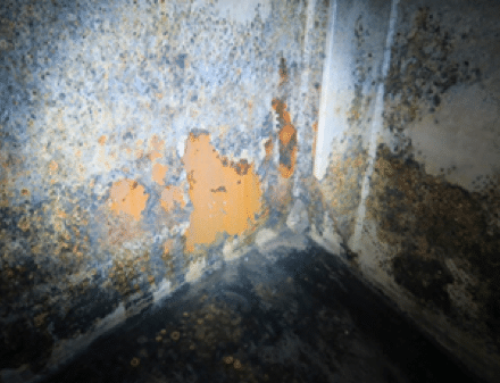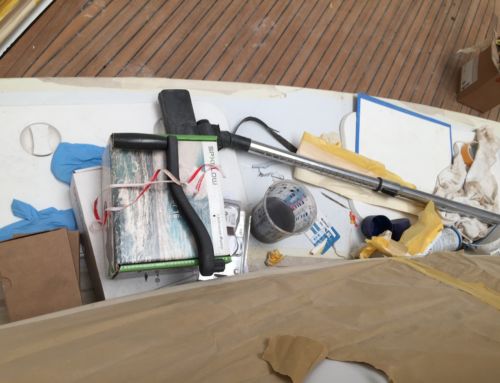The Mediterranean refit season is nearly upon us and many yachts will be heading to the various refit shipyards once the summer season ends. It is widely known that repainting a yacht is one of the most complex aspects of a refit, even if it’s just a basic “scratch and shoot”. It happens all too often that a vessel leaves the shipyard sporting a paint job that is not quite to the satisfaction of the owner and crew. In fact, it is not unheard of for a yacht to leave the shipyard with a paint finish inferior to what it had before the refit! So the question that begs to be answered is: what can be done to make a refit paint job a success?
WHY IS YACHT PAINT SO TRICKY?

Perfect paint jobs are achieved through a well-managed preparation period and expert supervision during the work process.
Yacht painting is complicated business; always has been and probably always will be. The requirements of yacht paint are extreme, perhaps almost impossibly demanding. On the one hand, the super yacht industry requires a finish that is on par with a luxury motor vehicle, such as a Bentley. On the other hand, we constantly subject that paint finish to some of the most extreme conditions imaginable: exposure to UV rays, salt, oil, soot – as well as constant stress caused by torsion in the ship’s construction due to wave impact. We then expect this shiny paint finish to last many years, too!
The result of these demands is that a superyacht paint job is built up using a range of wildly varying and technically complex products that require adherence to an extremely tight set of conditions when applying them. There is the great pressure felt by paint manufacturers, who must deliver high performance products capable of withstanding the most inhospitable conditions, while simultaneously ensuring that their product formulations meet the strict requirements of environmental legislation.
The complexities of yacht paint also take a heavy toll on the paint crews. The demands on them are high because of the many products with which they must be acquainted, each brand having its own particular idiosyncrasies. Add to that the often demanding time schedules and the fact that paint work can often be interrupted due to conflicting work activities such as welding and teak laying – and it is easy to understand how yacht paint application is fraught with the risk of failure.
PREVENTING PAINT FAILURE: 6 KEYS
For the purpose of guiding our clients to paint application success, we have identified 6 crucial keys
1. CLOSELY MANAGE THE TENDER PROCEDURE
An initial paint survey is essential before the tender procedure can be initiated. Using the data and observations gathered during the survey an accurate scope of work can be drafted. The scope of work contains a full round-up of all work activities and areas that need to completed. The more comprehensive the scope of work, the less confusion there is over what is and isn’t included in the overall cost of the paint job.
This information should be added to a bid document, which can then be sent to the shortlisted yards or contractors. These documents not only make it easier for the contractor to bid on the job, but they also allow the decision maker a more accurate comparison of the quotes.
For more information about a tender procedure managed by CCS please read our article ‘Refit? Consider a tender procedure managed by CCS’.
2. THOROUGHLY DRAFT/CHECK ALL CONTRACTS AND OTHER DOCUMENTATION
A PAINT SPECIFICATION covers the full paint system on all parts of the yacht and outlines surface preparation and minimum workmanship requirements.
ACCEPTANCE CRITERIA stipulate the quality standards that the shipyard and contractor must deliver upon completion. It might include parameters concerning surface texture (orange peel), gloss levels, maximum allowable dust inclusions (particle size and density), tolerable deflections in surface fairness, etc.
3. HAVE A KICK-OFF MEETING WITH ALL PARTIES IN ATTENDANCE
To ensure all parties are on the same page from the beginning and that all important aspects of the project are discussed, we recommend a kick-off meeting. It allows owners and crew to clearly communicate their requirements and expectations. Steps covered in the meeting include:
- Go through the planning submitted by the yard; intercept potential snags before they occur.
- Run through all documentation: Scope of work, contracts, acceptance criteria, etc. Make sure the contractor is aware of the expected quality standards.
- Explain to the contractor what is required in terms of good workmanship.
- Discuss the locations of cut lines proposed by the yard or contractor by drawing them into a General Arrangement (GA).
- Go over the prerequisites pertaining to ambient conditions during paint activities, tenting requirements, equipment, paint storage, etc.
- Confirm that the painters will not be impeded by conflicting work activities or other delays.
- Define the role of the paint manufacturers. Are they going to supervise? If so, when and how? And with what authority?
- Establish clear lines of communication.
4. CARRY OUT REGULAR INSPECTIONS DURING THE WORK PROCESS
Inspections during key points of the work help ensure quality workmanship and adherence to the coating manufacturers’ directions. They allow corrective action to be taken before mistakes leads to paint disasters, delays and budget overruns. A company such as CCS can manage, adjust, and coach your project to completion, thus lifting the weight of this complicated task off the shoulders of the captain and crew.
5. HAVE A FINAL SURVEY FOR ACCEPTANCE PERFORMED
Once the work is completed, a full survey will document the technical and aesthetic quality of the new paint system. This final survey can be used to hold the yard or contractor accountable if the ACCEPTANCE CRITERIA have not been met. The report can also be used to analyze paint degradation over time by serving as a benchmark.
6. HAVE A SURVEY CARRIED OUT JUST BEFORE THE WARRANTY EXPIRES
Using the data collected during the final survey as a benchmark, CCS can accurately and objectively assess any paint degradation over time by performing another survey just before the warranty expires. If CCS finds paint failures or excessive degradation, the yard or contractor can be held accountable by comparing the objective data gathered in each survey.
FINAL THOUGHTS
As independent paint consultants we see time and time again that a well-managed preparation period combined with expert supervision during the work process is the key to success. To take the first step in getting your refit the relaxed way, feel free to contact one of us at CCS. We are dedicated to seeing that your yacht gets the quality paint job it deserves and can assist with all or any of the 6 keys mentioned in the article.





